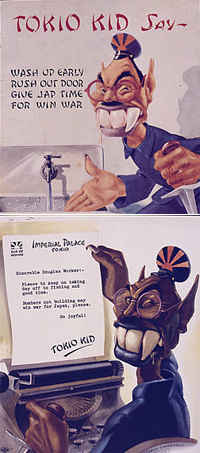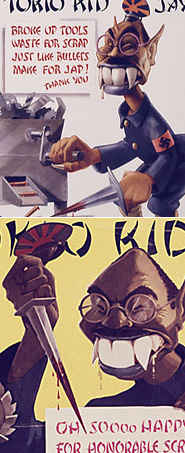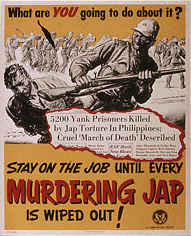|
Racist Propaganda During World War II, the U.S. government printed a massive run of propaganda posters that occupy a unique place in American history.
During World War II, the U.S. government printed a massive run of propaganda posters that occupy a unique place in American history. The War Production Board was established in 1942 with a mandate to take over the U.S. economy and convert it into a production machine for war materiel. As part of its mission, the WPD encouraged American workers to spend every waking moment on war-related efforts. Some of the posters were commissioned and produced in-house, while others were submitted by Americans who wanted to help the war effort. Although many of the posters are relatively simple messages about workplace safety and the importance of the home front, the series features some of the most racist imagery ever produced by the American government. After Pearl Harbor, the U.S. arrested thousands of ethnic Japanese, seized their property and placed them in internment camps. Although U.S. history was rife with racism of every stripe, the outpouring of hate toward the Japanese after the Pearl Harbor was unique for its sudden onset and its official sanction.
By the 1940s, America was in the midst of a communications revolution, thanks to movies, radio and perhaps most importantly, the invention of offset printing, which exponentially boosted capacity in the U.S. to produce newspapers, pamphlets and color posters. The WPD exploited the latter capability to its fullest. It produced thousands of posters within just two years time, littering American factories with endless exhortations to home front workers to remember the soldiers, avoid absenteeism and recycle scrap for the war effort—all for the purpose of defeating America's unspeakably evil enemies. A significant number of these posters aimed to demonize America's enemies—the Axis nations of Germany, Italy and Japan. Anti-German sentiment was predictably embodied by Hitler, but Mussolini spoke for the guinea. The Japanese were treated differently. Although many posters caricatured Tojo, the supreme commander of Japan's army, many more simply caricatured a demonized racial stereotype of the Japanese—to such extremes that the racial identity of the characters are frankly unrecognizable to someone familiar with Japanese people but not with the stereotype itself. There is a certain, difficult to define quality to racial caricature that causes them to drip with hate. American's WWII anti-Japanese propaganda posters are obscenely successful as a government-endorsed vehicle for that quality. Japanese are presented as yellow drooling, well-fanged, blackfaced, blood-sucking, chong-fonging, rong-donging demons who menace everything America holds dear, often with a spooky dagger in hand. Many of the pictures feature evil "Jap" soldiers threatening the women of America's homeland, a pastoral theme which was also transposed for the Nazis. Many WPD posters parodied Tojo, at least in principle. In practice, however, the generic racial caricatures often overwhelmed anything specific to Tojo, with the exception of his glasses, uniform and mustache. The extremely broad range of depictions runs from simply recreating Tojo with an air of menace to gross exaggerations of his (largely nonexistent) racial characteristics (the teeth, the eyes, etc.). As a rule, racism doesn't need to be terribly imaginative, which may explain why Tojo's caricature occasionally takes on the characteristics of black racial caricature instead of looking even remotely Japanese.

 A particularly attractive series of posters is distinguished by the above-average artistic skill with which they were executed and an excruciating parody of the broken English which Americans imagined the Japanese spoke.
A particularly attractive series of posters is distinguished by the above-average artistic skill with which they were executed and an excruciating parody of the broken English which Americans imagined the Japanese spoke.The "Tokio Kid" series represents a vicious nadir of racial stereotyping in the WPD posters, which probably explains their success. The Tokio Kid depicts the Japanese (embodied by another character presumably inspired by Tojo) as mythic monsters, resembling vampires more than humans. The Tokio Kid mocked American workers for their sloth and careless waste, their failure to save scrap and their frequent absenteeism from factories which supported the war effort. The Tokio Kid was so successful that he inspired a cheap knockoff, Tokio Joe. Although Joe was equally hateful, the artwork was uninspired and his impact was far smaller. Many of the WPD posters doubled-up on the hate content by mimicking other images associated with racial hatred and other forms of bigotry. (Ironically, a handful of posters warned about the enemies' prejudices, telling Americans to report anyone overheard casting aspersions on Catholics, Protestants and Jews.)
| ||||

 While the federal government endorsed slavery through the 19th century, there was no need to persuade the public of its merits—the challenge had been to do the opposite—and the vagaries of commercial printing processes at the time would have made such efforts expensive.
While the federal government endorsed slavery through the 19th century, there was no need to persuade the public of its merits—the challenge had been to do the opposite—and the vagaries of commercial printing processes at the time would have made such efforts expensive. 

